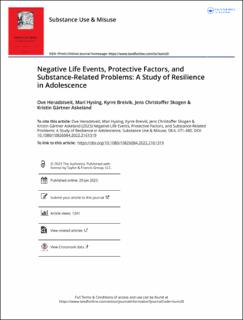| dc.contributor.author | Heradstveit, Ove | |
| dc.contributor.author | Hysing, Mari | |
| dc.contributor.author | Breivik, Kyrre | |
| dc.contributor.author | Skogen, Jens Christoffer | |
| dc.contributor.author | Askeland, Kristin Gärtner | |
| dc.date.accessioned | 2023-10-02T13:46:23Z | |
| dc.date.available | 2023-10-02T13:46:23Z | |
| dc.date.created | 2023-02-26T14:44:38Z | |
| dc.date.issued | 2023 | |
| dc.identifier.citation | Substance Use & Misuse. 2023, 58 (4), 471-480. | en_US |
| dc.identifier.issn | 1082-6084 | |
| dc.identifier.uri | https://hdl.handle.net/11250/3093512 | |
| dc.description.abstract | Background There is compelling evidence for an association between negative life events (NLE) and substance-related problems (SRP) during adolescence. The literature is, however, still limited with regards to protective factors for SRP among adolescents exposed to NLE. Methods A large population-based survey including 9,611 Norwegian adolescents aged 16 to 19 years, comprised the dataset of this study. The main explanatory variable was NLE. The main outcome variable was SRP, assessed by the CRAFFT scale. Potential protective factors were measured with five subscales from the Resilience Scale for Adolescents (READ) questionnaire. The potential protective factors and sex were explored as moderators for the associations between NLE and SRP. Results NLE were strongly associated with SRP. Four out of five potential protective factors (i.e., Goal Orientation, Self-confidence, Family Cohesion, and Social Support) showed evidence of a protective-stabilizing effect. Even if they had protective effect across all levels of exposure to NLE, these effects were even stronger for adolescents with high exposure. For Family Cohesion a protective-stabilizing effect was only evident for boys, while a direct protective effect was found for girls. Finally, Social Competence was the only factor that did not show any evidence of promoting resilience toward SRP. Conclusions NLE had a strong relation with SRP in this study. Protective factors buffered against SRP for all adolescents – but particularly so for adolescents who had high exposure to NLE. These findings highlight the need for preventive efforts to strengthen protective factors that may promote resilience among adolescents at risk for SRP. | en_US |
| dc.language.iso | eng | en_US |
| dc.rights | Attribution-NonCommercial-NoDerivatives 4.0 Internasjonal | * |
| dc.rights.uri | http://creativecommons.org/licenses/by-nc-nd/4.0/deed.no | * |
| dc.title | Negative Life Events, Protective Factors, and Substance-Related Problems: A Study of Resilience in Adolescence | en_US |
| dc.title.alternative | Negative Life Events, Protective Factors, and Substance-Related Problems: A Study of Resilience in Adolescence | en_US |
| dc.type | Peer reviewed | en_US |
| dc.type | Journal article | en_US |
| dc.rights.holder | © 2023 The Author(s) | en_US |
| dc.description.version | publishedVersion | en_US |
| cristin.ispublished | true | |
| cristin.fulltext | original | |
| cristin.qualitycode | 1 | |
| dc.identifier.doi | 10.1080/10826084.2022.2161319 | |
| dc.identifier.cristin | 2129338 | |
| dc.source.journal | Substance Use & Misuse | en_US |
| dc.source.volume | 58 | en_US |
| dc.source.issue | 4 | en_US |
| dc.source.pagenumber | 471-480 | en_US |

